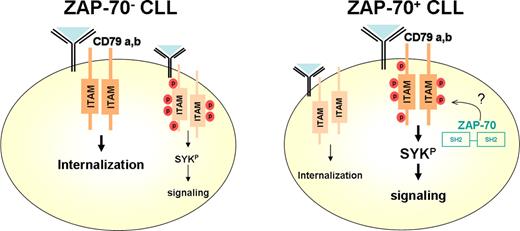The finding that ZAP-70 is often expressed in the B-cell chronic lymphocytic leukemia (B-CLL) cells of patients who, in general, have a more aggressive disease course was one of the first clinically relevant data to emerge from gene-expression microarray technology.1 Before then, the ZAP-70 protein tyrosine kinase was thought to be expressed only in T-lineage cells, associated with phosphorylated immunoreceptor tyrosine–based activation motifs (ITAMs) of the T-cell receptor ζ chain following receptor engagement.
Chen, Kipps, and their colleagues have been instrumental in furthering our understanding of the unexpected association between ZAP-70 expression and poor B-CLL prognosis. They determined that ZAP-70 enhances Ig receptor signaling in B-CLL cells.2,3 This finding was particularly surprising because B-CLL cells express the related Syk protein whose kinase activity is 100-fold higher than that of ZAP-70,4 and which, unlike ZAP-70, can be activated in an Src-kinase–independent fashion.5
In this issue of Blood, Chen and colleagues shed light on this issue, demonstrating that the 2 functional SH2 domains of ZAP-70 are required for enhanced IgM signaling in B-CLL cells, whereas the ZAP-70 SH1 kinase domain is dispensable. In addressing the mechanism(s) underlying this effect, Chen and coworkers eliminate the possibility that ZAP-70 facilitates Ig-receptor signaling by competing for binding to c-Cbl, an E3 ubiquitin ligase that targets proteins for proteosomal degradation. Indeed, the enhancing role of ZAP-70 is independent of its ability to interact with c-Cbl.
The second hypothesis that the authors go on to establish is that ZAP-70, but not Syk, enhances phosphorylation of the ITAMs in the Ig signaling subunit, the CD79a/CD79b (Ig-α/Ig-β) heterodimer. They find significantly higher levels of CD79b phosphorylation following anti-μ treatment in ZAP-70–expressing B-CLL cells than in their ZAP-70–negative counterparts. This hypothesis is partially at odds with the conventional “ordered” model of TCR/BCR signaling, wherein phosphorylation of ITAM tyrosines is mediated solely by Src-family kinases. However, several lines of evidence had already suggested that, at least in T cells, this simplified model might be flawed. In murine thymocytes as well as human T cells, ZAP-70, but not Syk, was shown to promote phosphorylation of ITAMs in the TCR-ζ chain, an effect that was also independent of ZAP-70 kinase activity.6,7
The authors' “plan B” proposes that ZAP-70 enhances BCR signaling in B-CLL cells by promoting phosphorylation of the ITAMs in the Ig signaling subunit. In this context, it is notable that Hou et al8 recently showed that BCR phosphorylation and internalization are mutually exclusive events. Specifically, the same tyrosine residues in the BCR complex regulate 2 distinct fates; phosphorylation results in signaling, whereas the absence of phosphorylation results in receptor internalization.8 While it is crucial to determine whether this phenomenon occurs in B-CLL cells, support for this proposition comes from the recent demonstration that introduction of ZAP-70 into the ZAP-70–negative BJAB lymphoma cell line leads to decreased ligand-mediated BCR internalization, even though ectopic ZAP-70 has very low catalytic activity.9 Furthermore, using an analog-sensitive Syk mutant, a very recent study showed that the length of time for which anti–IgM-BCR complexes are retained at the cell surface significantly shapes signaling fates; NFκB is immediately activated, whereas activation of NFAT requires that BCR complexes and the associated Syk molecule be phosphorylated for more than 1 hour.10 These effects might be expected to be more pronounced in B-CLL cells, in which levels of CD79b are significantly lower than on normal B lymphocytes.11,12 In this model, downstream BCR signaling in B-CLL cells is mediated by the Syk kinase, but optimal cell-surface expression and phosphorylation of the BCR requires the presence of the ZAP-70 kinase (see figure).
ZAP-70 enhances BCR signaling in B-CLL cells by promoting CD79 phosphorylation. In the proposed model, the increased levels of CD79a and CD79b phosphorylation in B-CLL cells expressing ZAP-70 are dependent on the presence of the 2 ZAP-70 SH2 domains. The mechanisms via which ZAP-70 enhances phosphorylation of CD79a/CD79b are not yet known, but may be the result of a direct interaction between the ZAP-70 SH2 domains and the phosphorylated ITAMs. The phosphorylation of CD79a/CD79b would result in an augmented phosphorylation of Syk and activation of downstream signaling cascades while limiting BCR internalization. In the absence of ZAP-70, the decreased phosphorylation of CD79a/CD79b would limit Syk phosphorylation and downstream signaling but would result in significantly higher levels of BCR internalization.
ZAP-70 enhances BCR signaling in B-CLL cells by promoting CD79 phosphorylation. In the proposed model, the increased levels of CD79a and CD79b phosphorylation in B-CLL cells expressing ZAP-70 are dependent on the presence of the 2 ZAP-70 SH2 domains. The mechanisms via which ZAP-70 enhances phosphorylation of CD79a/CD79b are not yet known, but may be the result of a direct interaction between the ZAP-70 SH2 domains and the phosphorylated ITAMs. The phosphorylation of CD79a/CD79b would result in an augmented phosphorylation of Syk and activation of downstream signaling cascades while limiting BCR internalization. In the absence of ZAP-70, the decreased phosphorylation of CD79a/CD79b would limit Syk phosphorylation and downstream signaling but would result in significantly higher levels of BCR internalization.
Many questions remain, including the phosphorylation status of the Ig-α/Ig-β heterodimer, the relative association of ZAP-70 versus Syk with the Ig-α/Ig-β heterodimer in B-CLL cells as well as in normal B cells, the ZAP-70–dependent enhancement of signaling in B-CLL cells but not normal B cells, and finally, the mechanisms responsible for the distinct role of ZAP-70 in promoting CD79b phosphorylation in B-CLL cells. Irrespective of the answers, the present work by Chen and colleagues unveils a new ZAP-70–dependent pathway wherein the catalytic activity of ZAP-70 does not appear to contribute to the aggressive nature of ZAP-70+ B-CLL. This has significant ramifications for the development of new therapeutic strategies for B-CLL patients, targeting ZAP-70 and/or the BCR itself.
Conflict-of-interest disclosure: The authors declare no competing financial interests. ■
REFERENCES
National Institutes of Health
Author notes
A.M.-H. and R.V. contributed equally to this work and are listed alphabetically.


This feature is available to Subscribers Only
Sign In or Create an Account Close Modal